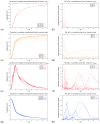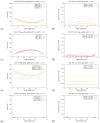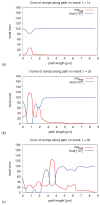Advanced Hepatitis C Virus Replication PDE Models within a Realistic Intracellular Geometric Environment
- PMID: 30759770
- PMCID: PMC6388173
- DOI: 10.3390/ijerph16030513
Advanced Hepatitis C Virus Replication PDE Models within a Realistic Intracellular Geometric Environment
Abstract
The hepatitis C virus (HCV) RNA replication cycle is a dynamic intracellular process occurring in three-dimensional space (3D), which is difficult both to capture experimentally and to visualize conceptually. HCV-generated replication factories are housed within virus-induced intracellular structures termed membranous webs (MW), which are derived from the Endoplasmatic Reticulum (ER). Recently, we published 3D spatiotemporal resolved diffusion⁻reaction models of the HCV RNA replication cycle by means of surface partial differential equation (sPDE) descriptions. We distinguished between the basic components of the HCV RNA replication cycle, namely HCV RNA, non-structural viral proteins (NSPs), and a host factor. In particular, we evaluated the sPDE models upon realistic reconstructed intracellular compartments (ER/MW). In this paper, we propose a significant extension of the model based upon two additional parameters: different aggregate states of HCV RNA and NSPs, and population dynamics inspired diffusion and reaction coefficients instead of multilinear ones. The combination of both aspects enables realistic modeling of viral replication at all scales. Specifically, we describe a replication complex state consisting of HCV RNA together with a defined amount of NSPs. As a result of the combination of spatial resolution and different aggregate states, the new model mimics a cis requirement for HCV RNA replication. We used heuristic parameters for our simulations, which were run only on a subsection of the ER. Nevertheless, this was sufficient to allow the fitting of core aspects of virus reproduction, at least qualitatively. Our findings should help stimulate new model approaches and experimental directions for virology.
Keywords: (surface) partial differential equations; 3D spatiotemporal resolved mathematical models; Finite Volumes; computational virology; hepatitis C virus (HCV); massively parallel multigrid solvers; mathematical models of viral RNA cycle; population dynamics; realistic geometries; viral dynamics; within-host viral modeling.
Conflict of interest statement
The authors declare no conflict of interest. The founding sponsors had no role in the design of the study; in the collection, analyses, or interpretation of data; in the writing of the manuscript, and in the decision to publish the results.
Figures





















Similar articles
-
Intracellular "In Silico Microscopes"-Comprehensive 3D Spatio-Temporal Virus Replication Model Simulations.Viruses. 2024 May 24;16(6):840. doi: 10.3390/v16060840. Viruses. 2024. PMID: 38932132 Free PMC article.
-
3D Spatially Resolved Models of the Intracellular Dynamics of the Hepatitis C Genome Replication Cycle.Viruses. 2017 Sep 30;9(10):282. doi: 10.3390/v9100282. Viruses. 2017. PMID: 28973992 Free PMC article.
-
Quantitative Analysis of Hepatitis C NS5A Viral Protein Dynamics on the ER Surface.Viruses. 2018 Jan 8;10(1):28. doi: 10.3390/v10010028. Viruses. 2018. PMID: 29316722 Free PMC article.
-
Membrane association of hepatitis C virus nonstructural proteins and identification of the membrane alteration that harbors the viral replication complex.Antiviral Res. 2003 Oct;60(2):103-9. doi: 10.1016/j.antiviral.2003.08.017. Antiviral Res. 2003. PMID: 14638405 Review.
-
Phosphorylation of hepatitis C virus NS5A nonstructural protein: a new paradigm for phosphorylation-dependent viral RNA replication?Virology. 2007 Jul 20;364(1):1-9. doi: 10.1016/j.virol.2007.01.042. Epub 2007 Apr 2. Virology. 2007. PMID: 17400273 Review.
Cited by
-
Influence of T-Bar on Calcium Concentration Impacting Release Probability.Front Comput Neurosci. 2022 May 2;16:855746. doi: 10.3389/fncom.2022.855746. eCollection 2022. Front Comput Neurosci. 2022. PMID: 35586479 Free PMC article.
-
Intracellular "In Silico Microscopes"-Comprehensive 3D Spatio-Temporal Virus Replication Model Simulations.Viruses. 2024 May 24;16(6):840. doi: 10.3390/v16060840. Viruses. 2024. PMID: 38932132 Free PMC article.
-
Spatio-Temporal Analysis of Infectious Diseases.Int J Environ Res Public Health. 2019 Feb 25;16(4):669. doi: 10.3390/ijerph16040669. Int J Environ Res Public Health. 2019. PMID: 30823539 Free PMC article.
-
Efficient Estimates of Surface Diffusion Parameters for Spatio-Temporally Resolved Virus Replication Dynamics.Int J Mol Sci. 2024 Mar 5;25(5):2993. doi: 10.3390/ijms25052993. Int J Mol Sci. 2024. PMID: 38474240 Free PMC article.
-
A review of historical landmarks and pioneering technologies for the diagnosis of Hepatitis C Virus (HCV).Eur J Clin Microbiol Infect Dis. 2025 Jun;44(6):1289-1303. doi: 10.1007/s10096-025-05110-y. Epub 2025 Mar 22. Eur J Clin Microbiol Infect Dis. 2025. PMID: 40119224 Review.
References
-
- Romero-Brey I., Merz A., Chiramel A., Lee J., Chlanda P., Haselman U., Santarella-Mellwig R., Habermann A., Hoppe S., Kallis S., et al. Three-dimensional architecture and biogenesis of membrane structures associated with hepatitis C virus replication. PLoS Path. 2012;8:e1003056. doi: 10.1371/journal.ppat.1003056. - DOI - PMC - PubMed
Publication types
MeSH terms
Substances
LinkOut - more resources
Full Text Sources
Research Materials

